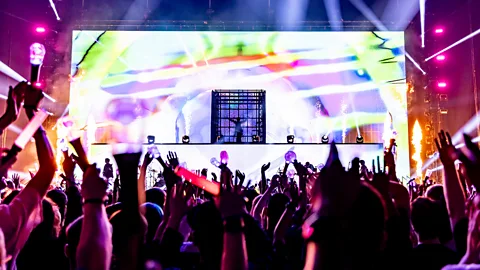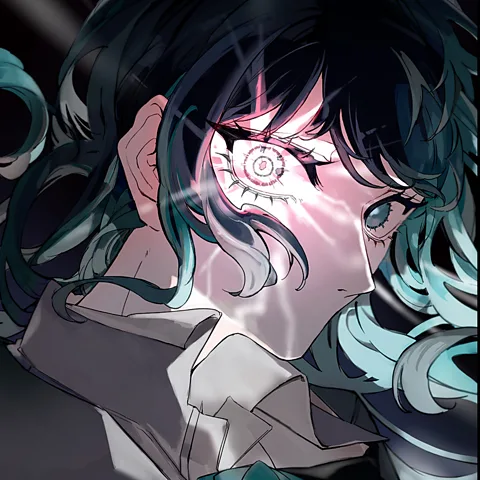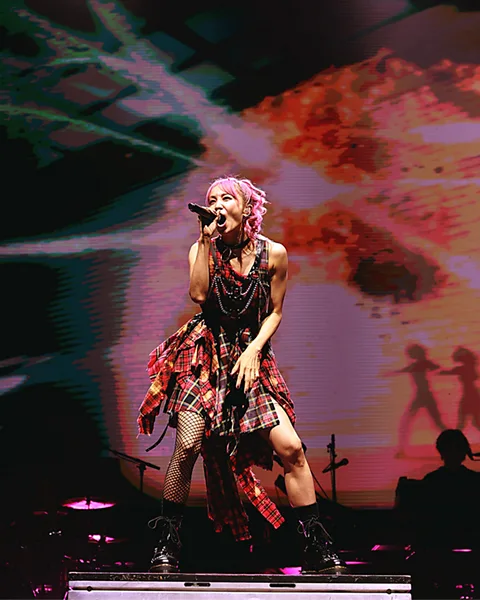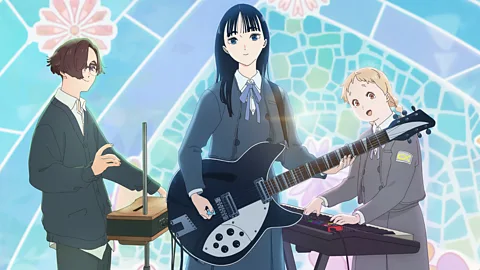'They scream the choruses': How Japanese anime songs became Gen Z's latest musical obsession
 Viola Kim
Viola KimSince the Covid-19 pandemic, music from Japanese animations is booming on Spotify and at gigs and club nights – especially among young people, who are drawn to its bold hooks and big emotions.
Around 20,000 rapturous fans have packed out London's O2 Arena on a summer night. Pulsing light sticks pierce the electrified air; on the stage, the enigmatic J-pop diva Ado (who performs in shadowy silhouette) launches into a song that the entire crowd knows: Kura Kura, taken from the Japanese animation series Spy x Family. The track is stylistically unpredictable yet immediately catchy: it ricochets between a 1960s-style pop groove, jazzy riffs and hyper-dramatic rock opera – a modern example of an anime music anthem, in a scene that is increasingly taking on a life of its own.
Japanese animation, or anime, has a legacy that stretches back to the early 20th Century, and a creative scope that spans seemingly endless stories and styles, from pirate sagas to sci-fi warfare; sorcery to sports action; martial arts mythology to star-crossed romance. The music used to soundtrack it is similarly adventurous. Songs vary significantly in their genres and tempos (often shape-shifting within a single track), but they also share common qualities: they elevate the visual action and deeply seal our bond with it. In the digital age, vividly evocative, insistently snappy themes are key to the viral impact of iconic Japanese animated series/films/manga comic adaptations – One Piece, Demon Slayer, Jujutsu Kaisen, Dragon Ball Z, Cowboy Bebop, Attack On Titan and Naruto, to name a few. "Anisongs", as they are known, are now a major musical force, particularly among younger people.
 Universal Music LLC
Universal Music LLCAccording to a recent study by anime streaming platform Crunchyroll and the National Research Group, anime is almost as big as Beyoncé with Gen Z-ers, with 54% of them globally being anime fans. Meanwhile Spotify reported a 395% increase in global streams of anime music between 2021 and 2024, as well as 7.2 million user-generated anime playlists on its site (at the time of writing). A Spotify spokesperson also tells the BBC that users under the age of 29 account for nearly 70% of global anime music consumption.
"Anime music has evolved into a global cultural force and Gen Z is really at the heart of that movement on Spotify," Sulinna Ong, Spotify's Global Head of Editorial, tells the BBC. "We're seeing fans connect with the music beyond the screen as the shows offer listeners a window into musical styles they may not otherwise have discovered. Our editors' curated playlists are built to help fans discover the full range of anime-inspired sounds. And as more artists take influence from the space, the sound is continuing to grow in bold and unexpected ways."
This global boom isn't limited to 21st-Century releases; as it's now easy to tune into anime's expansive catalogue, decades-old anthems – like the original rousing theme to pirate fantasy One Piece, called We Are! and sung by Hiroshi Kitadani – are winning new devotees. Anime music's hooks are composed for enduring effect; the melodies and lyrics (easily translated online, or released in multilingual versions) typically spark a tantalising headrush of sensations: affinity with favourite characters or narratives; adrenaline; escapism; nostalgia. As Satoshi Uto, Crunchyroll's director of music acquisition, tells the BBC: "The OPs and EPs [opening and end credit songs] are critical to fans' emotional connection with anime."
An example of a smash hit anisong is Japanese singer-songwriter Lisa's 2019 track Gurenge, which is the intro to anime series Demon Slayer: Kimetsu no Yaiba. This elegant power ballad with explosive rock flourishes has inspired countless tributes, from TikTok influencers (such as young British piano talent Joe Jenkins) to the 2020 Tokyo Olympics closing ceremony (where it was included as an instrumental symphony). It is also sentimentally character-driven, as Lisa explained in a Billboard Japan interview: "I tried placing myself in the shoes of the protagonists, who keep forging ahead, despite their tragic pasts."
The reasons for the boom
The timing of audience spikes does suggest that the pandemic era played a pivotal part in the mainstream awakening to both anime and its atmospheric tunes; this form's fantastical themes, emotional intensity and free-ranging sounds may have represented a heady escape from lockdown constraints. In a 2022 article, The Hollywood Reporter noted, that "anime might just be the world's most Covid-resistant form of popular entertainment", referencing a study that showed global demand for anime content grew 118% between 2020 and 2022.
 Getty Images
Getty Images"You're looking at a massive spike in the availability of anime to new fans [based on a growing array of online platforms], and the time they had on hand to watch it," explains Jonathan Clements, author of books including the British Film Institute's Anime: A History. "And in the years since, a bunch of young fans have become consumerist teens with a love of anime.
For young fans, anime music offers a gateway to Japanese pop culture and beyond. It also has lifted up a new wave of stars onto a worldwide platform. Examples include the vibrantly catchy J-pop duo Yoasobi, whose 2023 track Idol, taken from the manga comic adaptation Oshi no Ko, became the first anime song to top the Billboard Global Chart; hip-hop act Creepy Nuts, whose viral smash Bling-Bang-Bang-Born, which is the intro for anime Mashle: Magic And Muscles, is a surreal bop blending quickfire rap and Latin licks; and melodic rockers Radwimps' soaring anthems for Makoto Shinkai's fantasy-dramas (Your Name; Weathering With You; Suzume). Ado's catalogue contains numerous anime themes, and her worldwide breakthrough was fuelled by the blockbuster success of One Piece Film Red, in which she sang tracks including the exhilarating electro-pop banger New Genesis, in character as the antihero Uta.
"When I first heard the demo for New Genesis, it felt like the world had opened up and a warm ray of light had shone through," Ado tells the BBC. "The character, Uta, is full of human touch in a good way," she says, adding that this song slickly captures the protagonist's complexity: "She is able to express feelings of joy and happiness, but also anger, hatred and sadness in a very simple relatable way."
Keeping up with this prolific scene can feel dizzying, but it regularly yields thrilling discoveries, and its blend of bold hooks, gripping storytelling and persuasive nostalgia seems to bring generations together more than most music – as I've found as a Gen X woman, geeking out alongside my Gen Alpha son. "Someone to look out for is [anime soundtrack composer] Kensuke Ushio, whose attention to detail and realism is truly astounding," says Clements. "On [2024 coming-of-age drama] The Colours Within he had to come up with the sound of the in-film garage band, carefully crafting electronic pop inspired by the early days of New Order. He even went as far as recording ambient sound in Japanese church halls, to ensure that the on-screen rehearsal sessions had the right room tone."
Anime music in the live arena
Anime music also increasingly translates to real-life realms, whether it's international concert tours from veteran composers such as Joe Hisaishi, the maestro famous for his work on the films of Studio Ghibli, or contemporary hitmakers including Ado and Yoasobi, or inclusive meet-ups and club events like those hosted by UK "diversity-led anime and gaming collective" Anime & Chill.
 Filmworks
Filmworks"For Gen Z specifically, anime hits differently," says Anime & Chill founder Eneni Bambara-Abban. "This is a generation raised on global internet culture, where J-pop, K-pop and anime AMVs [anime music videos] are part of the same online ecosystem.
"Platforms like TikTok and YouTube have also given anime songs a second life – clips go viral, people remix them, and suddenly, a theme from a niche show becomes a global anthem. We see it all the time at our events… the crowd knows the lyrics, they scream the choruses and they feel it." She emphasises the "emotional imprint" of these songs: "Anime music isn't just background music – it's the heartbeat of the [work]."
Notable too is how Western musicians are getting in on anime culture. Back in 2003, French electronic duo Daft Punk re-imagined their Discovery album as an anime feature: Interstella 5555 (supervised by legendary artist Leiji Matsumoto); it seemed like a quirky curiosity at the time. But nowadays, a surge of western musicians reference anime in their own material, whether it's US hip-hop stars like Lil Uzi Vert and Megan Thee Stallion, or alt-pop heroine Billie Eilish name-checking characters in their lyrics and song titles, or London indie rapper Shao Dow who writes personal tracks based around famous anime series, and tells the BBC: "I use anime as a vehicle to explore ideas within my life". He adds that One Piece's teenage captain Luffy provided early creative influence: "I would look at this character who'd scream about being the king of the pirates, and people would laugh, but he'd keep doing it. Even though it's a cartoon, that positive energy inspired me: he's pushing forward with this dream."
Perhaps that's the ultimate power of anime songs; you can grow up with this music, but you never really grow out of it.
--
If you liked this story sign up for The Essential List newsletter, a handpicked selection of features, videos and can't-miss news, delivered to your inbox twice a week.
